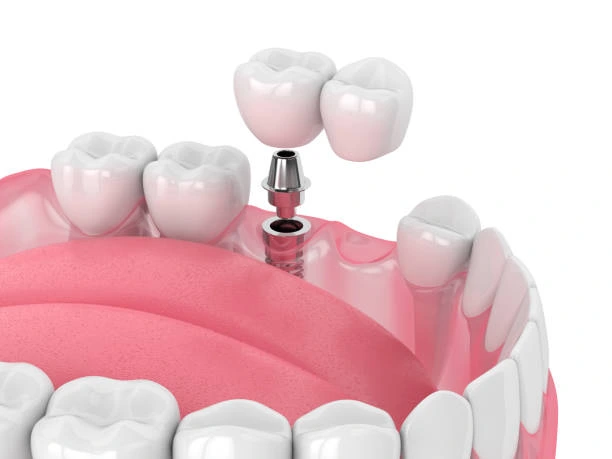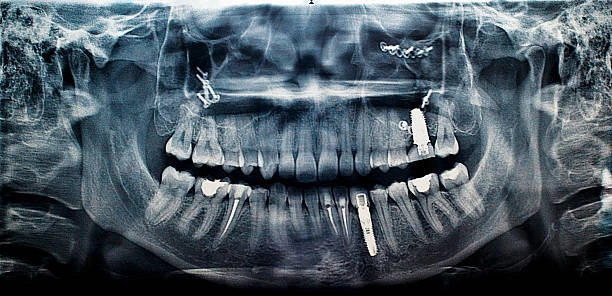There are two of the most popular options when it comes to replacing the missing teeth namely dental implants and dental bridges, but how do you determine which one to choose? It is not only a matter of filling a hole in your smile when you make a choice between them, but of long-term comfort, function, appearance, and oral health. Having a lost tooth because of injury, decay, or gum disease, it is better to know the advantages and disadvantages of each choice and make a confident and informed decision. To make the comparison easier, we are going to take apart the differences and you can decide what works best with your smile and your lifestyle.
Understanding the Difference Between Implants and Bridges

As far as the replacement of missing teeth is concerned, two of the most common solutions are presented, i.e. dental implants and dental bridges. Although both are meant to perform the same purpose, which is to replace missing teeth, they are very different in how they do that. Learning how each of them works, what it entails, and what effect it has on your oral health can assist you in the process of selecting the solution that best suits your needs. To get a better understanding of what makes these two options different, let us examine it a little more closely.
What Are Dental Implants and How Do They Work?
Dental implants are a lasting, dependable treatment to substitute missing teeth. Each implant has a tiny titanium post that is placed surgically into the jawbone to act as an artificial root of the tooth. The implant is securely and naturally fitted over time through a process known as osseointegration where the implant fuses with the bone. After some months of healing, a specially made crown is cemented on, which looks, feels, and functions just like a natural tooth. The outcome is a lasting and pretty replacement that keeps the jawbone healthy and makes the face shape the same.
How Dental Bridges Replace Missing Teeth
Dental bridge is a non-invasive procedure of replacing missing teeth literally by bridging the gap. The prosthetic device has one or more artificial teeth (referred to as pontics) which are held in position by dental crowns that are cemented to the adjacent healthy teeth. It is usually faster than implants because the process does not require surgery. But bridges depend on the power of neighboring teeth, which are likely to be weakened with time because of the extra pressure. They also, in contrast to the implants, do not stimulate jawbone, which can potentially cause the bone loss in the future. Nevertheless, bridges may prove to be a viable option- particularly in instances where the adjacent teeth are already in need of crown or restoration.
Materials Used in Implants vs. Bridges
Titanium or zirconia are usually used to make dental implants because these materials are strong, durable, and biocompatible. The porcelain or ceramic crown that fits on top is normally of the same color as your natural teeth and is supposed to match seamlessly. Bridges, however, can be made of metal alloys, porcelain fused to metal or all-ceramic material. Both options have their advantages and disadvantages in terms of looks, durability and price.
The material you use is certainly a factor that determines how your restoration will appear and perform in the future. It is therefore important to discuss with your dentist what will best suit your needs; be it on the aesthetic look, strength, budget, or all the three.
Pros and Cons of Dental Implants
The gold standard of missing teeth replacement is dental implants- as with any procedure, these have both benefits and drawbacks. Knowing the advantages and disadvantages will enable you to make an informed choice as to whether or not implants are the right choice to your smile, lifestyle, and long-term oral health.
Long-Term Durability and Bone Health Benefits
Among the strongest advantages of dental implants is the fact that they are very durable. They can be used to replace lost teeth and with proper oral care and dental visits, they may last decades or even a lifetime, making them a permanent solution to denture. In addition to durability, implants are important in maintaining the density of the jawbone. They promote the bone and prevent bone loss that normally occurs when teeth are extracted since they resemble the natural root of a tooth. Not only does this aid in a younger facial framework, it also maintains the teeth around it, making them less prone to shifting. Unlike other bridges, dental implants do not need to cut down the healthy teeth to fit them in and thus you are able to keep more of your original smile.
Surgical Considerations and Healing Time
Implantation of a dental implant is a simple procedure that is executed through minor surgery. In the procedure, a titanium post is implanted into the jawbone, which is an artificial tooth root. When in position, the healing process starts- during this time the bone integrates with the implant to form a solid base, a process known as osseointegration. This process normally lasts a number of months and it may be different depending on the general health of an individual and osteoporosis. It could take longer in case a bone graft is required to strengthen the jawbone in advance. It can be a tiresome process but the long-term and naturalistic results make it a worthwhile investment to many patients.
Implant Cost and Insurance Coverage Factors
Although dental implants are often more expensive in the short term as compared to traditional bridges, their long-term durability can be considered more economical in the end. The implants are supposed to serve decades of use and this means that no further replacement or repair is necessary. Certain dental insurance plans might help cover a part of the implant procedure, but coverage differs significantly between provider and plans. It is a good tip to call your insurance company and ask them what is covered. Moreover, numerous dental practices provide payment plans or financing to allow implants to be more easily and cheaply available.
Pros and Cons of Dental Bridges
One of the solutions to missing teeth is the dental bridges. They literally bridge that gap with one or more artificial teeth which are held in place by adjacent natural teeth or implants. Although bridges have a number of advantages, they also have a couple of disadvantages depending on your oral health and long-term objectives. The advantages and disadvantages are briefly summarized as follows.
Faster Restoration Without Surgery
The bridges only involve two dental visits and they can make your smile in a significantly lesser time as compared to the implants. The procedure is minimally invasive, which may be less threatening and more comfortable to many patients because it involves no surgery at all. This renders dental bridges a favorable alternative to those who prefer a faster, simpler fix-especially the ones who cannot undergo surgery because of health reasons, loss of bone or age.
A dental bridge once installed can be used to instantly regain the ability to chew, talk and smile with confidence. Modern bridges are made of strong materials that closely resemble your natural teeth in color and shape to provide a functional and natural-looking result. A bridge in most instances is also useful in preventing the displacement of neighboring teeth and thus ensuring good positioning and bite.
Impact on Adjacent Teeth
The disadvantage of dental bridges is that they require support of adjacent teeth. The neighboring teeth need to be filed down and crowned to firmly fix the bridge to the teeth- a procedure that permanently changes the structure of the teeth. Should these teeth be in good condition, the loss of a little of the enamel may seem like a sacrifice.
With time, the extra load of holding the bridge could weaken the teeth or render them susceptible to the decay process, particularly in the event the oral hygiene is not observed. It also has a risk of developing future complications, e.g. cavities or cracks in the supporting teeth, which may cause further dental treatment. These are some of the risks that must be put into consideration when choosing between a bridge and other tooth restoration methods such as implants.
Lifespan, Maintenance, and Replacement Needs
The longevity of dental bridges ranges between 5 to 15 years depending on the quality of materials as well as your bite and care on your part. The oral hygiene such as brushing and daily flossing under the bridge and dental appointments should be maintained well to prevent complications such as gum disease or decay in the supporting teeth. The bridge can also need to be repaired or replaced over time due to natural wear and tear and this can add to the overall long term cost. Bridges, however, offer a reliable, functional and cost-effective medium-term solution to restoring their smile and ability to chew, to many patients.
Choosing Between Implants and Bridges Based on Your Situation
Whether you prefer dental implants or bridges will depend on some of the personal considerations such as your oral health, financial and time constraints, and long-term objectives. Both of them are good alternatives to replacing lost teeth, yet they also have their benefits and drawbacks. Knowing your individual needs, as well as talking to your dentist can be the best way to make the most effective choice regarding your smile and overall health.
Bone Density, Oral Health, and Budget Concerns
When you have enough bone density, and overall good health, dental implants are usually the best option because of their long-lasting nature and capacity to maintain the jawbone structure. They perform the same way as natural teeth and assist in preserving the facial aesthetics by avoiding bone loss. Not all patients, though, are implant candidates; patients with limited bone volume, uncontrolled health conditions, and patients who do not want to undergo surgery may discover that implants are not an option without further steps, such as bone grafting. An alternative to this, which is effective and stable, can be a dental bridge. Another factor is cost: implants are usually more expensive initially, but can be more cost-effective in the long run as they last longer and do not need much maintenance. Bridges, however, are much less expensive to start with but can be costly to repair or replace in the future.
When Bridges May Be a Temporary or Permanent Solution
Other patients would prefer the dental bridges as a stop gap measure before they can get the implants. This staged procedure gives one time to save up the more expensive implants or time to get prepared, like bone grafting or other procedures. In other cases, a bridge is a permanent solution because of medical reasons, anatomical factors or cost factors that would make implants more impractical. Although bridges do not have the same bone saving advantages of implants, they are a dependable alternative, restore the ability to chew, and enhance the look of your smile. Finally, the optimal option will be based on your personal situation and long-term plans regarding your dental health.
How to Decide with Your Dentist’s Guidance
The decision on whether to use dental implants or bridges has to be made with due consideration of your oral health, your personal preferences, and your lifestyle requirements. Some of the main aspects that your dentist will consider to find the best option to suit you include bone density, condition of the gums and the surrounding teeth. One should always make in-depth inquiries on the life span of the treatment, the dangers involved, any maintenance involved, and the total cost of each therapy. This makes you well informed and at ease with your choice. Under the professional advice and with the clear perception of your possibilities, you may easily proceed to the healthier and complete smile.
Frequently Asked Questions (FAQs)
1. Which lasts longer: a dental implant or a bridge?
Dental implants typically outlast bridges, often lasting a lifetime with proper care and maintenance. In contrast, dental bridges usually last between 5 to 15 years before needing repair or replacement. The durability of both options depends on factors like the quality of materials, oral hygiene habits, and regular dental checkups. Implants have the added benefit of stimulating the jawbone, which helps preserve bone density over time. Bridges, while effective, don’t offer this same advantage and may lead to gradual bone loss in the missing tooth area. Overall, implants tend to be the more long-lasting and biologically supportive option.
2. Are dental implants more expensive than bridges?
Yes, dental implants typically have a higher upfront cost compared to bridges. However, bridges may require repairs or replacements over the years, which can increase long-term expenses. Many patients find that implants offer better overall value due to their durability and lower maintenance needs. Additionally, implants help preserve bone health, which can prevent future dental issues. Insurance coverage differs widely, so it’s important to check with your provider to understand what’s included. Your dentist can also help you explore financing options to make treatment more manageable.
3. Can I switch from a bridge to an implant later?
In many cases, a dental bridge can be replaced with an implant later on. This is a common choice for patients seeking a more permanent solution. However, if significant bone loss has occurred beneath the bridge, a bone graft may be required to support the implant. Regular dental checkups and imaging can help monitor bone health and determine if the switch is possible. Your dentist will assess your individual case and guide you through the necessary steps to ensure a successful transition.
4. Do implants feel more natural than bridges?
Implants are designed to closely mimic the feel and function of natural teeth, making them a more comfortable option for many patients. Because they are securely anchored into the jawbone, implants remain stable and don’t shift or put pressure on surrounding teeth. This stability often leads to a more natural chewing and speaking experience. Bridges, while effective, rest on neighboring teeth and may take more time to adjust to. Some patients may experience slight discomfort or sensitivity at first. Ultimately, comfort varies from person to person and depends on individual anatomy and preferences.
5. Is one better for chewing and eating?
Dental implants generally provide greater stability and strength for chewing, closely replicating the performance of natural teeth. Anchored directly into the jawbone, implants can withstand more pressure and distribute biting forces evenly. This makes them especially suitable for patients who enjoy a varied diet, including harder or tougher foods. While bridges can also restore chewing function effectively, they rely on adjacent teeth for support and may not offer the same level of force distribution. Both options can work well, but your choice should be based on your specific needs, lifestyle, and dental health.
Ready to Restore Your Smile?
If you’re considering dental implants or bridges, the best first step is a personalized consultation with your dentist. They’ll assess your oral health and help you explore your best options for restoring function and confidence. Don’t wait to take care of your smile—early planning can lead to better results and fewer complications. Contact Graham Park Dental today to schedule a visit and take the first step toward a healthier, complete smile.


